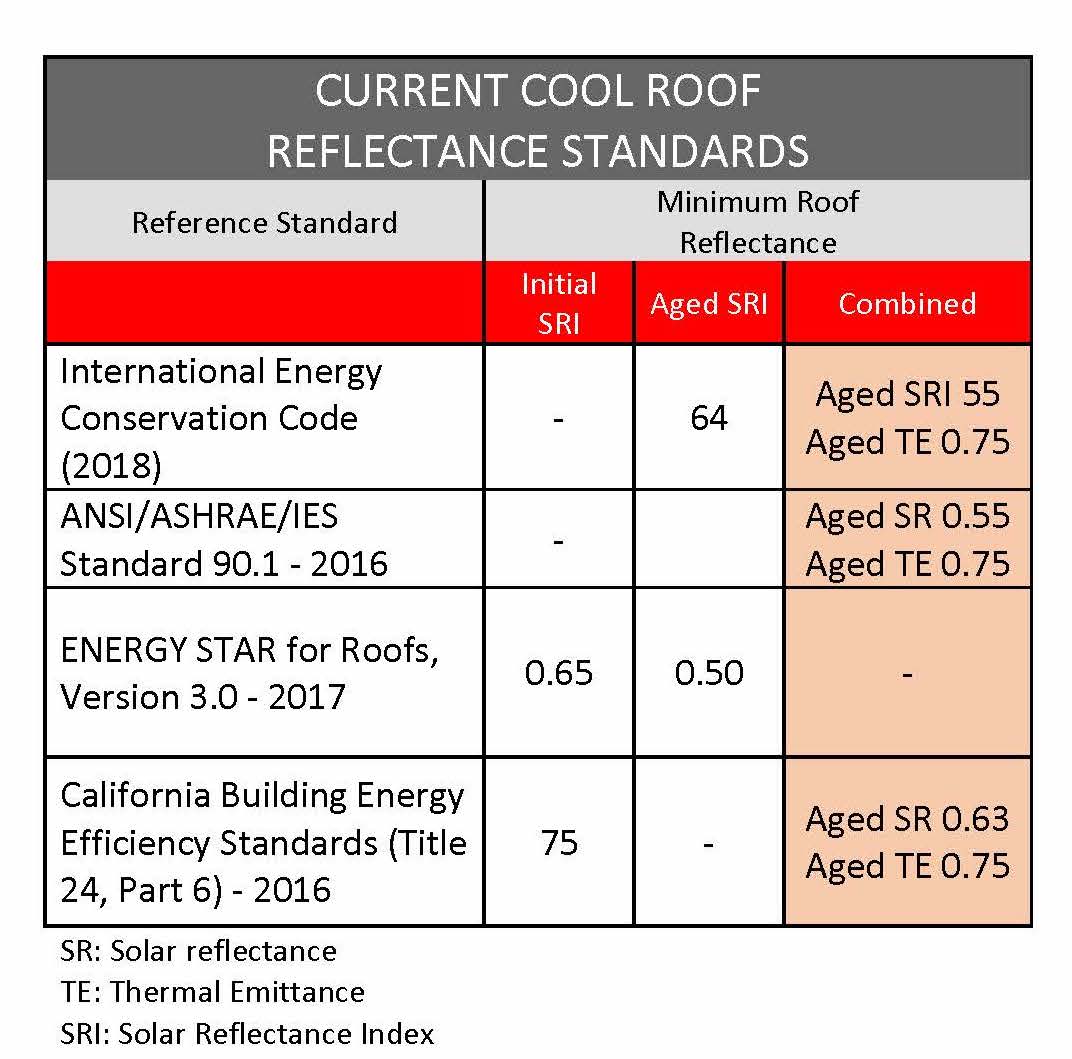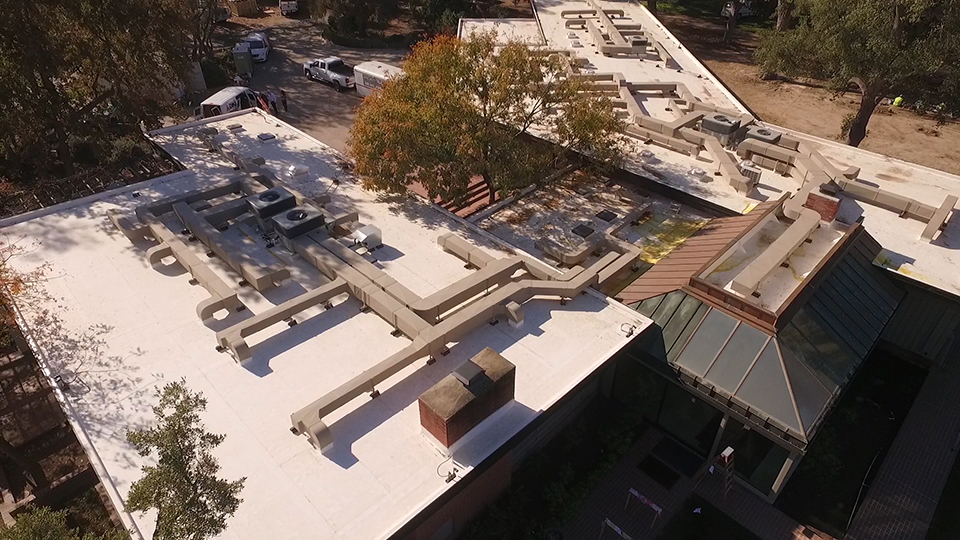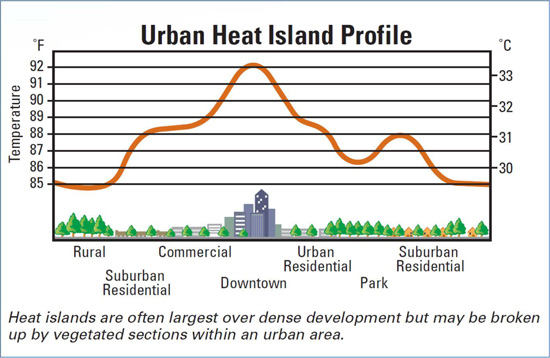Cool Roofs for a Hot Planet
What are Cool Roofs?
Among the solutions to decrease energy use and thus decrease emissions from burning fossil fuels are cool roofing systems. Cool roofs use a highly reflective surface to direct a significant portion of solar heat from the sun away from the building. Unlike a dark or non-reflective roof surface that absorbs and transfers solar heat into the building and the surrounding neighborhood, a light-colored, reflective roof surface reflects and drives solar heat away from the building and into the atmosphere or beyond. Reflecting the sun’s energy to keep cool is an ancient strategy that has been made modern with science and innovation. Cool roofs have been widely available in the U.S. marketplace for more than 25 years.
Cool roofs can be achieved using a wide variety of roofing technologies, including single-ply membranes, cool-surfaced modified asphalt systems, and metal roofing panels. A wide variety of roof coatings may be applied to many different roofing surfaces. For any of these roofing products to be “cool” by today’s standards, the minimum percentage of solar heat reflected away from the building typically falls within a range of 0.50 (50 percent) to 0.70 (70 percent), depending on the particular standard being applied and the aging of the sample tested. The table to the left shows the most-recognized building codes and standards.iv

Benefits of Cools Roofs
The cheapest roof is rarely the least expensive. While the upfront cost of the cheapest roof possible may appeal to an owner, the long-term benefits that will be sacrificed makes it a very bad bargain. While budget may seem like the overriding concern, the primary goal should be to design and construct a watertight roofing system as well as a superior building that will not only create a healthier and more comfortable environment for occupants, but will save the owner or operator money and trouble in the long run. In many cases, educating the owner is necessary so that the best decision for long-term benefits can be made.
There are compelling “talking points” that explain the real costs and benefits of a cool roof:
- Insulation is from 25 to 50 percent more effective. When insulation gets hot, it is less effective at doing what it is supposed to do—slow heat movement through the surface. The science shows that extremely high temperatures reduce the effective R-value of the most widely used types of insulation (Leonard & Leonard, 2005).
- Improved HVAC efficiency. Inlet air temperature can be 5 degrees to 15 degrees cooler 30 inches above the roof surface. Most HVAC units are designed with efficiency ratings evaluated at 95 degrees (York International, 2005).
- Reduced heat flux. Studies from Princeton University show with modeling and field tests that reflectivity noticeably reduces heat flux on roofs with as much as R-48 insulation. The authors conclude that cool roofs make sense because they save in the summer and don’t really affect winter heating, especially in roofs with high levels of insulation.v
- Ambient interior temperatures can be 15 to 20 degrees cooler than outside with a cool roof. According to a report by the Lawrence Berkeley National Laboratory and other researchers: “In many commercial buildings, thermal conditions are not controlled well due to insufficient cooling or heating capacity, high internal or external loads, large thermal zones, improper control-system design or operation, or other factors.” The results of the study on worker productivity show that performance increases with temperature up to 70 to 71 degrees Farenheit, and decreases with temperature above 73 to 74 degrees Fahrenheit. The highest productivity is a temperature of around 71 to 72 degrees Fahrenheit. For example, at the temperature of 86 degrees Fahrenheit the performance is only 91.1 percent of the maximum, with the reduction in performance of 8.9 percent. In short, cool roofs can contribute to lowering the interior temperature and maintaining comfort levels for the occupants.
Analysis of energy bills shows that peak demand charges accounts for a significant portion of monthly electric bills across the United States and that cool roofs provide an equally significant opportunity to reduce these charges when installed on air-conditioned buildings.
A sharp peak in electrical demand can be observed in buildings during the busiest hours of the day. Although a share of this peak may be attributed to equipment use in the building, a significant portion is caused by increased demand for air-conditioning in the heat of the afternoon. This peak in demand requires additional power plant capacity, leads to a greater chance of brownouts and blackouts, and may result in increased air pollution.
But most importantly for your client, the building owner, peak demand may result in monthly charges many times higher than the base electrical rates. One of the best approaches to shrink peak demand is to reduce the heat load on a building, especially the solar load that drives the need for air-conditioning. Few heat-reduction strategies can match the energy-saving potential of modern cool roofing technology. Click here for more information on reducing peak electrical demand.

Photo courtesy of Duro-Last, Inc.
Rooftop HVAC equipment has been shown to work more efficiently in combination with a cool roof.
Heat islands are those urban areas where the temperatures will be hotter than the surrounding areas. Lawrence Berkeley National Laboratory (LBNL) has been the main research agency and proponent of heat island mitigation activities.vii
As the chart below shows, on average the difference in afternoon temperatures between rural and urban land is 7 degrees Fahrenheit. In some areas, the difference is as much as 10 degrees Fahrenheit. This difference can increase during extended heat waves.
Three key factors make up the overwhelming majority of the 7-degree heat island difference:
- Fifty-six percent of the effect is due to less vegetation in the urban land compared to rural land (about 4 degrees).viii
- Dark paving causes 6 percent of the difference (less than ½ degree).
- Thirty-eight percent is directly attributed to dark roofing (almost 3 degrees).
Let’s consider the possible solutions to heat islands. Adding vegetation will certainly help. However, it is a long-term improvement, requiring 10, 20, even 50 years to reap full benefits of, for instance, mature leafy trees. Such a remedy is constantly in a catch-up mode because construction and expansion continually removes vegetation.
Replacing dark pavement with lighter-colored paving could also have a positive effect. Indeed, technology to make lighter pavement exists. But this is also a long-term solution and requires significant capital outlays for somewhat minimal benefit.
However, replacing dark roofing with light, reflective cool roofing provides the biggest bang for the buck. By raising reflectivity, we can offset the warming impact. Relative to other possible mitigations measures, it is easy to accomplish, relatively inexpensive, and provides immediate benefits to lessen the impacts of heat islands on a heating planet.

Image courtesy of the Environmental Protection Agency
This chart shows that on average the difference between rural and urban areas is 7 degrees Fahrenheit, with some areas as much as 10 degrees hotter. This difference can increase during extended heat waves.vi
Following the long trend toward verifiable results that has arisen in the sustainable building industry, the Cool Roof Rating Council (CRRC) was created in 1998 “to develop accurate and credible methods for evaluating and labeling the solar reflectance and thermal emmitance (radiative properties) of roofing products and to disseminate the information to all interested parties.”ix
To become certified by CRRC, manufacturers must have their products tested and rated. The U.S. Department of Energy’s ENERGY STAR® program also offers a certification process for cool, reflective roofing.x









